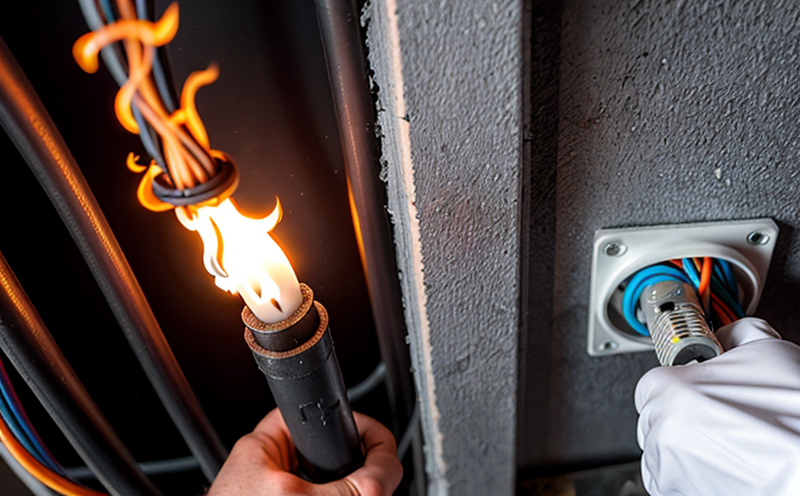Fire Resistance Testing of Aerospace Cables
The aerospace industry demands exceptional standards in safety and reliability. Among these requirements is ensuring that cables and wiring systems can withstand extreme conditions without compromising performance or integrity. Fire resistance testing plays a critical role in achieving this goal by simulating the harsh environments encountered during flight, particularly those involving electrical fires.
Fire resistance tests are designed to evaluate how well cables perform under controlled fire exposure. This includes assessing insulation materials for their ability to prevent flame spread and maintain functionality even when exposed to high temperatures. The aerospace sector relies on these tests as a vital component of ensuring that all components meet stringent safety regulations before deployment.
The testing process involves placing the cable specimens in an oven or furnace where they are subjected to controlled levels of heat for extended periods. During this time, various parameters such as temperature rise rates and duration are carefully monitored to determine how well each specimen withstands the thermal stress. Once the test concludes, analysts examine both qualitative aspects like char depth and quantitative measures like weight loss percentage.
Compliance with relevant standards is essential when performing fire resistance tests on aerospace cables. International standards such as ASTM E1354, ISO 6722, and EN 50265 provide detailed guidance on the procedures involved in conducting these assessments accurately. These guidelines ensure consistency across different laboratories worldwide, promoting trust among stakeholders.
Accurate reporting is critical for documenting test results comprehensively. Reports typically include descriptions of the specimens tested along with details about the testing conditions and outcomes. They also outline any deviations from expected behavior or performance issues identified during the evaluation process.
The importance of fire resistance testing cannot be overstated given its direct impact on passenger safety, operational efficiency, and overall reliability within the aviation industry. By investing in robust cable systems that pass rigorous fire tests, manufacturers contribute significantly towards enhancing aircraft safety standards globally.
Benefits
Ensures compliance with international safety regulations such as ASTM E1354, ISO 6722, and EN 50265.
Enhances reliability by confirming that cables can operate effectively under severe thermal stress without failure.
Promotes passenger safety through reduced risk of electrical fires on board aircrafts.
Safeguards operational efficiency by minimizing disruptions caused by component failures due to fire incidents.
Why Choose This Test
Investing in comprehensive fire resistance testing offers numerous advantages for manufacturers and operators within the aerospace industry. Firstly, it helps ensure that products meet stringent safety requirements set forth by governing bodies worldwide. Secondly, successful completion of these tests provides assurance to customers about the quality and reliability of your offerings.
Moreover, participating in rigorous testing demonstrates a commitment to excellence, fostering trust among end-users who rely heavily upon dependable electrical systems for safe travel experiences. Lastly, compliance with recognized standards can open doors to new markets where stringent safety measures are mandated by law or custom practice.
Use Cases and Application Examples
In the context of aerospace applications, fire resistance testing is particularly crucial given the demanding operating environments faced by commercial airlines and military aircrafts. Here are some examples illustrating its real-world application:
Testing communication cables used in satellite communications systems to ensure uninterrupted signal transmission even during emergencies.
Evaluating power distribution networks for ensuring continuous supply of electricity needed for essential functions like lighting and navigation systems.
Assessing fuel lines that must remain intact and functional despite exposure to intense heat sources such as engine exhausts.
These examples underscore the importance of fire resistance testing in maintaining high standards across diverse areas of aviation technology. By incorporating this critical step into your quality assurance process, you can significantly contribute towards enhancing both operational efficiency and passenger safety within the aerospace industry.





